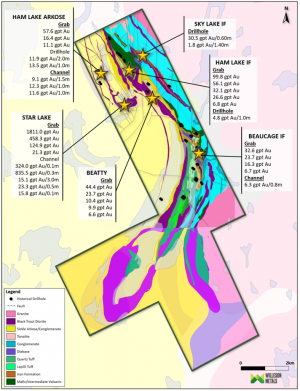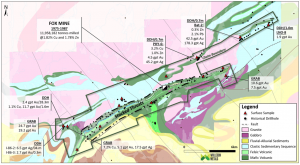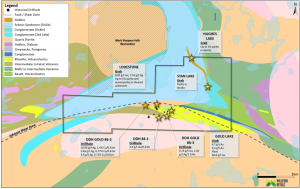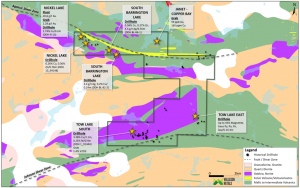Beaucage Property
The Beaucage Property (“Beaucage”) is located 55 km by air south-southeast of the town of Lynn Lake, and is currently only accessible by floatplane, helicopter or by winter road (not been maintained and would require refurbishing). Beaucage consists of 23 contiguous mining claims encompassing 5,888 hectares. Claims are 100% owned by Willeson.
Beaucage lies along the contact of the Lynn Lake Volcanic Belt and Kisseynew Gneissic Basin of the Churchill Province. The property is known to host multiple styles of gold mineralization, including iron formation-hosted; structurally controlled stockwork and veins in clastic sediments; and quartz-filled shear zones in the Black Trout Diorite. Beaucage boasts numerous significant gold assay values in multiple favourable geological settings. The property has seen little modern exploration; many of the high-grade gold occurrences have not been systematically explored in almost 30 years.
Hatchet Property
The Hatchet Property (“Hatchet”) is located approximately 30 km west of the town of Lynn Lake and is accessible via provincial highway 396. The property consists of 48 contiguous mining claims units encompassing 11,722 hectares. Claims are 100% owned by Willeson.
Hatchet extends 30 km along the western extent of the Johnson Shear Zone and contains several shear-hosted high-grade gold showings with visible gold and polymetallic-rich quartz veins, as well as base metal showings, including the past-producing Fox Mine, which operated for 15 years producing 11.96 million tons grading 1.8% copper and 1.78% zinc1. There is potential for high-grade gold mineralization in the underexplored western convergence of the Agassiz and Johnson shear zones within favourable lithologies in a stacked thrust fault environment.
Hughes Property
The Hughes Property (“Hughes”) is located approximately 26 km east of the town of Lynn Lake and is accessible via provincial highway 391. The Property consists of 10 claims covering 2,559 hectares. Claims are 100% owned by Willeson.
Hughes contains multiple historical gold occurrences and extends over a 10 km strike length of the Johnson Shear at the intersection of a major cross-structure and 15 km east of the past-producing Burnt Timber mine. This open-pit gold mine was operated by Black Hawk Mining Inc. between 1993 and 1996, producing a total of 80,000 oz2 gold. Alamos Gold now owns the Burnt Timber and the adjacent Linkwood deposits, reporting Indicated mineral resources of 1,021,000 tonnes grading 1.40 g/t gold (46,000 oz gold) and 984,000 tonnes grading 1.16 g/t gold (37,000 oz gold) respectively. Alamos also reports Inferred mineral resources of 23,438,000 tonnes grading 1.04 g/t gold (781,000 oz gold) at Burnt Timber and 21,004,000 tonnes grading 1.16 g/t gold (783,000 oz gold) at Linkwood3.
Barrington-Tow Property
The Barrington-Tow Property (“Barrington-Tow”) is located approximately 60km east of the town of Lynn Lake, in a relatively remote location that is currently only accessible via floatplane or helicopter or by winter road. The property consists of 14 claims covering 3,584 hectares. Claims are 100% owned by Willeson.
Barrington-Tow extends over 8 km of the Agassiz shear, which hosts Alamos’ 2.06 Moz gold Project3 to the west of the Property. The Property also covers a significant portion of the Tow Lake gabbro which was previously explored for nickel-copper and includes fault breccia, quartz veining, shearing and alteration, which is prospective for gold.
Historical drilling on the property identified numerous significant base metal and gold assay values in multiple favourable geological settings. Many of these high-grade mineral occurrences have not been systematically explored in almost 30 years. Additionally, 2019 prospecting identified historical trenches within the Tow Lake gabbro that assayed high-grade vanadium in an area previously focused on nickel-copper exploration.
1 1987 ‘Mining in Manitoba’, Manitoba Ministry of Energy and Mines
2 Richardson, D.J. and Ostry, G. 1996: Gold deposits of Manitoba; Manitoba Energy and Mines, Geological Services, Economic Geology Report ER86-1 (second edition), 114 p.
3 Alamos Gold stated proven and probable reserves as of December 31, 2020



